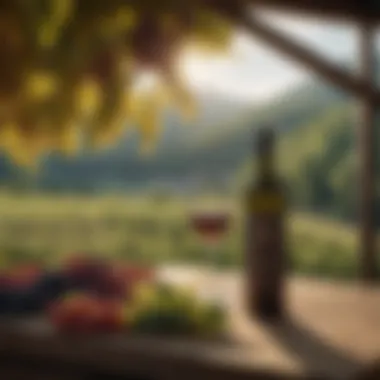Exploring Biodynamic Wine Brands: A Comprehensive Guide


Intro
Biodynamic wine is a fascinating subject that combines agriculture with philosophy and environmental stewardship. This method of viticulture promotes a holistic, ecological approach to farming. The principles drawn from biodynamics emphasize harmony in the vineyard ecosystem, where every element plays an essential role. This article will introduce you to the fundamental concepts of biodynamic farming. We will highlight prominent biodynamic wine brands and examine their influence. Moreover, it aims to deepen your understanding of how these wines can positively impact both the environment and the overall quality of the wine itself.
Principles of Biodynamic Farming
Biodynamic farming encompasses various techniques aimed at optimizing vineyard health and productivity. The core principles include:
- Soil health: Emphasis is on maintaining and improving soil vitality through natural composting and crop rotations.
- Cosmic influences: Planting and harvesting are often scheduled according to lunar cycles and astrological calendar, believing this affects growth.
- Biodiversity: Encouraging a rich variety of flora and fauna in the vineyard aids in pest control and natural growth promotion.
- Self-sustainability: Aiming for closed systems, where the farm generates its own fertilizers and compost.
This philosophical approach not only seeks to produce high-quality grapes but also aims to foster an active relationship between the vineyard and its surrounding ecosystem.
Notable Biodynamic Wine Brands
Understanding the brands that adopt biodynamic practices is crucial for any wine enthusiast. Here are a few notable names which exemplify the principles of biodynamic viticulture:
- Domaine de la Romanée-Conti: Located in Burgundy, France, this estate is renowned for its exceptional Pinot Noir and serious commitment to biodynamic methods.
- Tabali: Based in Chile, Tabali has integrated biodynamic practices into its winemaking, focusing on ecological sustainability.
- Château Maris: A French winery that combines biodynamic farming with innovative techniques, resulting in award-winning wines while preserving the environment.
Engaging with these brands provides insight into how biodynamic practices are implemented on a commercial level and the superior quality of wine they produce.
Impact on Environment and Wine Quality
Biodynamic wine production addresses several environmental concerns. By minimizing chemical usage, it significantly reduces pollution and promotes biodiversity. The focus on soil health leads to better grape quality, expressed as more complex and flavorsome wines. A study indicates that wines produced through biodynamic farming often show distinct characteristics, attributed to the healthier growing environment.
"Biodynamic wines stand out due to their nuanced flavors and greater depth, reflecting an authentic terroir that conventional methods often miss."
This indicates a clear connection between environmental practices and the sensory experience of wine. Thus, consumers looking for quality wine should consider biodynamic options not only for taste but for their contribution to sustainable practices.
End
Biodynamic wine represents a unique intersection of nature, agriculture, and philosophy. Understanding the principles and brands involved elevates the appreciation of these wines. In choosing biodynamic wine, consumers can make informed decisions that align with a commitment to environmental stewardship and quality. As we explore further into the world of biodynamic wine, it becomes evident that the choices made in the vineyard reflect not only on the bottle but also on our ecological responsibility.
Prologue to Biodynamic Wine
The significance of biodynamic wine transcends mere viniculture; it embodies a philosophy rooted in ecological stewardship and sustainability. This section elucidates the essence of biodynamic wine and its relevance in today's environmental landscape. As consumer awareness regarding organic and sustainable practices increases, biodynamic wines are gaining traction. They appeal to individuals who seek authenticity, quality, and a connection to nature in their wine choices.
Definition of Biodynamic Wine
Biodynamic wine is produced using methods derived from biodynamic agriculture, a holistic approach that emerged in the early 20th century. It blends organic farming techniques with spiritual and ecological principles, emphasizing the interconnectedness of the vine with its surrounding environment. This method prioritizes soil health, biodiversity, and the influence of cosmic rhythms on agriculture. Essentially, biodynamic certification requires practices such as planting based on lunar cycles, using specific compost preparations, and fostering a cooperative ecosystem within the vineyard.
"Biodynamic agriculture is not just about how to grow crops; it's about a way of thinking in relation to the cosmos and nature."
History and Development
The origins of biodynamic wine can be traced back to 1924, when Rudolf Steiner, an Austrian philosopher, introduced the concepts of biodynamic farming. Steiner's ideas were a response to the mechanization and chemical usage prevalent in agriculture at the time. He advocated for a more holistic and organic approach, calling for a restoration of the natural relationships between soil, plants, and animals. Over the decades, this philosophy evolved, giving rise to a community of growers and winemakers dedicated to biodynamic principles.
In the 1980s, the establishment of the Demeter Association formalized the certification of biodynamic products. This included wines, which began gaining recognition for their rich flavors and distinctive qualities. As biodynamic practices improved, the movement started to expand globally, particularly in regions like France, Italy, and California. Today, biodynamic winemaking is considered a hallmark of quality and sustainability in the wine industry.


Through this exploration, we see that biodynamic wines are not just a trend; they represent a profound shift toward sustainable agriculture. As we unfold the following sections, we will explore the core principles that underpin biodynamic farming, notable brands contributing to this movement, and the larger implications for both the environment and wine consumers.
Core Principles of Biodynamic Farming
Biodynamic farming stands as a unique approach within the wine industry, distinguishing itself through specific principles that advocate for sustainability and ecological health. Understanding these core principles is critical for grasping how biodynamic wines differ from traditional viticulture methods. The focus here is not only on the cultivation of grapes but also on fostering a holistic ecosystem. This practice integrates agricultural techniques, respect for nature, and a deep sense of responsibility towards the environment.
Holistic Approach to Agriculture
One of the fundamental tenets of biodynamic farming is its holistic approach. This means that a vineyard is seen not merely as a place to grow grapes but as part of a complex ecosystem. Biodynamic farmers view their land in conjunction with its surroundings, including soil, plants, animals, and even human elements. This interconnectedness promotes biodiversity and resilience, cultivating a vineyard that thrives naturally.
By prioritizing natural cycles and rhythms, such as lunar phases, biodynamic farming encourages practices that enhance the vineyard's ecosystem. Farmers often plant cover crops, reduce soil erosion, and enhance soil fertility naturally instead of relying on synthetic fertilizers or pesticides. The holistic methodology creates a vibrant environment, ultimately leading to grapes that reflect the unique characteristics of their terroir.
Soil Health and Organics
The emphasis on soil health is another principle central to biodynamic practices. Healthy soil is the foundation for quality grape production. Biodynamic farmers focus on practices that improve soil structure and fertility through organic methods. They often utilize compost preparations, which are made by fermenting specific plant materials, to enrich the soil and promote microbial activity.
Maintaining soil health has broader implications. The organic practices reduce chemical runoff that might affect the surrounding ecosystem. Biodynamic farming nurtures the soil's natural ability to foster plant growth, leading to improved grape quality and ultimately, a superior wine product. Here, the emphasis on organic methods aligns the farming practices with the essential goal of ecological balance.
Cosmic Influences on Wine Production
An often-discussed aspect of biodynamic farming is the consideration of cosmic influences. This principle posits that celestial movements, such as phases of the moon and specific constellations, can impact agricultural activities. Biodynamic practitioners often create planting and harvesting calendars based on these cosmic rhythms, believing that they can enhance plant growth and grape quality.
This element might seem unusual to some, but for biodynamic wine producers, it represents a deeper connection to nature. The lunar cycles can dictate the optimal times for various vineyard activities. In this context, the planning goes beyond conventional agricultural calendars, integrating broader natural forces that influence the vines.
"Biodynamic farming encapsulates a philosophy that intertwines agriculture with ecology, guiding practices that support a healthier environment and higher quality grapes."
The core principles of biodynamic farming revolve around a sustainable, integrated approach that considers both the immediate surroundings and cosmic factors. By fostering soil health, promoting organic practices, and embracing a holistic view of agriculture, biodynamic wine brands aim to produce wines that are not only sustainable but also community-oriented and rich in flavor.
Certification and Standards
Certification and standards are cornerstone elements within the domain of biodynamic wine production. They ensure that wines produced meet specific ecological and agricultural practices, which are crucial for the integrity of the biodynamic approach. The significance of certification stems from its role in establishing consumer trust and promoting high standards within the industry. Compliance with these certifications often requires rigorous adherence to biodynamic principles, ensuring that producers not only enhance vineyard health but also contribute positively to their local ecosystems.
The comprehensive certification processes act as a guarantee to consumers that the wine they are choosing has been produced in harmony with nature. This is vital, as many wine enthusiasts today are becoming more conscious about where their wine comes from and how it is produced. By choosing biodynamic wines, consumers are actively supporting sustainable farming practices that prioritize biodiversity and environmental health. This choice can influence market dynamics and encourage other producers to adopt similar practices.
Biodynamic Certification Process
The biodynamic certification process is meticulously structured. Initially, vineyards must apply for certification through recognized biodynamic organizations. A thorough evaluation of their practices and farm management is conducted. This often includes on-site inspections, which assess how closely the vineyard aligns with biodynamic philosophies.
Key steps in the certification process typically include:
- Application Submission: The vineyard submits an application outlining their farming practices.
- Inspection: An inspection is conducted by a certified auditor from the regulatory body.
- Evaluation: The practices are evaluated for compliance with biodynamic standards, which include utilizing organic methods, protecting soil health, and following lunar planting cycles.
- Certification Decision: The regulatory body makes a decision based on the inspection findings. A vineyard that meets the standards will receive a biodynamic certification.
- Ongoing Compliance: Certification is not a one-time effort; it requires ongoing compliance with biodynamic practices, subject to annual reviews.
It is important to note that some wineries may use the term 'biodynamic' without proper certification. Thus, consumers should look for certification labels to ensure their choice aligns with genuine biodynamic practices.
Regulatory Bodies
Several recognized bodies are responsible for the oversight and regulation of biodynamic practices. These organizations ensure that the standards are met and maintained across the industry. Some of the prominent regulatory bodies include:
- Demeter International: This is the leading international certification body for biodynamic agriculture. Founded in 1928, it is recognized globally and offers certification to biodynamic wine producers.
- Biodynamic Farming and Gardening Association (BDGAA): Located in the United States, the BDGAA promotes biodynamic practices among farmers and consumers. They provide information and resources for those seeking certification.
- Australian Certified Organic: This body certifies biodynamic practices in Australia, ensuring that producers comply with both organic and biodynamic standards.


The involvement of these bodies is crucial, as they formalize biodynamic wine's integrity and transparency. They advocate educational opportunities, thus fostering greater understanding and appreciation among consumers.
"Biodynamic wines not only reflect a commitment to quality but also to cultural and ecological responsibility."
Notable Biodynamic Wine Brands
The significance of notable biodynamic wine brands extends beyond their unique products. These brands represent a commitment to sustainable farming, environmental stewardship, and a holistic approach that affects both the land and the wine produced. By exploring these brands, one gains insight into the impacts of biodynamic practices on wine quality and ecological health. Notable biodynamic wineries also serve as examples for both consumers and producers in the growing field of sustainable viticulture.
Wine Brands in Europe
European biodynamic wine brands showcase a rich tradition rooted in terroir and community. These wineries often reflect centuries of craftsmanship coupled with modern sustainable practices. Each country contributes its own distinctive characteristics to biodynamic winemaking, enriching this practice across the continent.
Biodynamic Estates in France
Biodynamic estates in France, like Domaine Zind-Humbrecht, are exemplars of passionate winemaking intertwined with agricultural respect. The key characteristic of French biodynamic estates is their focus on terroir. This connection to the land not only enhances the quality of the wine produced but also fosters biodiversity within the vineyard ecosystem. \n These estates often embrace traditional methods while integrating biodynamic principles, which makes them a beneficial choice for conscious consumers. A unique feature of many French biodynamic estates is their use of preparations made from natural materials to enhance soil health and plant resilience. The advantages include superior wine quality and an increased market for environmentally-friendly products.
Leading Producers in Italy
Italy's leading producers, such as Radikon, highlight the importance of local varieties and indigenous practices. Known for their organic and biodynamic methods, these producers often emphasize minimal intervention in winemaking. This approach allows for a purer expression of the grape and its environment, appealing to those who value authenticity in wine.
The ability to produce wines that tell the story of their origins is a key characteristic that makes Italian biodynamic producers popular. A unique aspect of Italian biodynamic wineries is their emphasis on using traditional amphorae for aging wines, which imparts distinct flavors. However, the challenges include the need for rigorous monitoring of conditions and a more unpredictable market.
Wine Brands in North America
North America's biodynamic wine brands illustrate the adaptability of these practices to diverse climates and soils. From California to Oregon, these producers are making significant strides in both quality and sustainability.
Prominent Californian Brands
Californian brands like Frog's Leap have pioneered biodynamic farming techniques in regions that are often associated with large-scale, conventional wine production. The commitment to organic farming and biodiversity makes them notable in the wine landscape.
A key characteristic of Californian biodynamic wineries is their focus on ecosystem management. They foster a natural balance that allows for pest control without chemical intervention. Each of these practices can offer significant advantages, such as better-quality grapes and reduced environmental impact. Yet, some challenges may include scaling biodynamic practices in a way that meets growing consumer demand.
Emerging Producers in Oregon
Oregon's emerging biodynamic producers, such as Youkali, are gaining attention for their innovative approaches. These wineries not only produce high-quality wines but also emphasize regenerative practices that restore soil fertility.
The unique feature of Oregonian biodynamic practices is their focus on small-scale production and community involvement. This approach facilitates a deeper connection between consumers and the vine. The advantages include an enhanced local market presence and a strong narrative around sustainability. However, they may face the challenge of limited resources compared to larger operations.
Wine Brands in Australia and New Zealand
Australia and New Zealand have also embraced biodynamic winemaking, leading to a growing selection of wines that reflect their terroirs while adhering to sustainable practices. These brands contribute to a global movement towards more ecologically responsible viticulture.
The notable biodynamic wine brands in this region, though still on the rise, promote awareness about the interconnectedness of wine, agriculture, and the environment, culminating in a vibrant portfolio of wines that appeal to discerning consumers looking for quality and sustainability.
The Impact of Biodynamic Practices
Biodynamic practices have gained recognition not only for their unique approach to viticulture but also for their tangible effects on the environment and the economy. As more wine producers adopt these methods, it is essential to understand how biodynamic farming influences ecological health and economic viability. This section will explore the environmental benefits and the economic sustainability that arise from implementing biodynamic techniques in the vineyard.


Environmental Benefits
Biodynamic farming focuses on the health of the entire ecosystem. This holistic outlook encourages practices that work in harmony with nature. One of the primary environmental benefits of biodynamic agriculture is the enhancement of soil health. This entails using organic compost, crop rotation, and cover cropping to enrich the soil and promote biodiversity.
Moreover, biodynamic farms often employ a no-spray policy, minimizing reliance on synthetic pesticides and herbicides. This fosters a healthier environment for both plants and wildlife. The absence of harmful chemicals leads to an increase in beneficial insects, such as pollinators and natural pest-control agents. Thus, ecosystems around biodynamic vineyards become more robust over time.
"Biodynamic farming represents a unique commitment to sustainability, intertwining the health of the soil with the overall ecosystem."
In addition to improving soil health, biodynamic practices also emphasize water conservation. Wells managed with care ensure that there is minimal runoff from farming activities. Cover crops help retain moisture in the soil, reducing the need for irrigation. As climate change intensifies the challenges of water scarcity, these methods present viable solutions that promote sustainable resource management.
Economic Sustainability
Implementing biodynamic practices can also lead to notable economic sustainability for wine producers. Biodynamic wines often command a higher price point in the marketplace due to their perceived quality and the effort required to produce them. This creates a lucrative niche for producers committed to these practices.
Furthermore, the shift towards biodynamic farming can lead to reduced operational costs over time. By utilizing compost and organic amendments, producers can decrease their dependency on external inputs, such as chemical fertilizers and pesticides. This not only fosters self-sufficiency but also contributes to long-term financial health.
Additionally, many consumers are increasingly seeking out biodynamic wines. Their growing demand signifies a shift in market trends towards sustainability. As consumers become more eco-conscious, they tend to support brands that demonstrate a commitment to environmental integrity. This can ultimately yield strong customer loyalty and drive profitability.
Consumer Perception of Biodynamic Wines
Understanding consumer perception of biodynamic wines is crucial to grasping the broader implications of this unique agricultural approach. As the market continues to evolve, consumers become more discerning about their choices. Biodynamic wines, with their emphasis on ecological health and sustainable farming methods, are increasingly appealing to those who prioritize ethical consumption and environmental impact.
One key element attracting consumers is the awareness of healthier practices in winemaking. Biodynamic farming generally avoids synthetic pesticides and fertilizers. Many consumers are drawn to biodynamic wines for their perceived purity and better quality. The narrative around biodynamics often includes stories of vineyards that are closely integrated with their environment, offering a compelling reason to purchase from these sources.
Market Trends and Growth
In recent years, there has been a marked increase in the popularity of biodynamic wines. According to recent market research, the biodynamic wine sector has experienced a consistent growth trajectory. Consumers aged 25-45, particularly women, are the main drivers of this trend. They seek products that align with their values, such as sustainability and health. The growth can be attributed to various factors:
- Increased Awareness: More consumers are informed about the environmental impact of traditional farming practices. The demand for organic and biodynamic products is rising.
- Social Media Influence: Platforms like Instagram and Facebook play a significant role in shaping consumer perceptions. Influencers and brands highlight biodynamic practices, further cultivating interest.
- Wider Distribution: Retailers are recognizing the potential of biodynamic wines and are expanding their offerings in stores and online. This accessibility makes it easier for consumers to choose these wines.
As a result, biodynamic wines are not just a niche product anymore; they are entering the mainstream. Recent data indicates that growth in sales of biodynamic wines outpaces conventional wine categories.
Challenges in Mainstream Adoption
Despite the positive trends, there are challenges that hinder the full adoption of biodynamic wines in the mainstream market. One primary concern is the cost. Biodynamic wines often carry a higher price point. This can deter some consumers, particularly those who do not fully understand the value associated with biodynamic methods.
Another challenge is misconceptions surrounding biodynamic practices. Some consumers equate biodynamic farming with esoteric or mystical ideas rather than viewing it through a scientific lens. Their unfamiliarity can create skepticism about the validity of biodynamic claims.
Finally, limited availability remains a barrier. In certain regions, distribution channels for biodynamic wines are still developing. Without wider access, even interested consumers may find it hard to explore these products fully.
Epilogue: The Future of Biodynamic Wine
The exploration of biodynamic wine presents important implications for both producers and consumers. As the interest in sustainable agricultural practices grows, biodynamic wines offer a unique perspective on how farming and ecology can be intertwined. The wines produced under this philosophy are not just beverages but represent a broader commitment to environmental stewardship and sustainable practices.
Innovations in Biodynamic Practices
New techniques are developing within the biodynamic framework. For example, the integration of agroecological methods helps foster healthier ecosystems. This includes restructuring vineyard layouts to promote biodiversity. Additionally, advancements in technology, such as precision farming tools, allow vintners to monitor soil health and vine vigor more closely. These innovations enhance the effectiveness of traditional biodynamic practices. New methods for composting and resource recycling are being adopted as well, ensuring that waste products find new applications. By embracing change while valuing tradition, biodynamic viticulture can continue to evolve.
Potential for Global Expansion
Biodynamic wine is not limited to its origins. Many regions around the world are beginning to adopt these practices. The appeal of biodynamic principles not only addresses environmental concerns but also attracts consumers looking for quality and authenticity in their wine choices. There is a growing recognition that biodynamic wines can tap into emerging markets, particularly in nations where organic and sustainable products are in demand.
"As more consumers become aware of the ecological impact of their choices, biodynamic wines are likely to experience increased popularity."
This trend is also supported by the rise in consumer awareness regarding the origin of food and beverages, encouraging producers to focus on transparency and quality. In summary, biodynamic wine holds great promise for future growth, both in terms of agricultural practices and market reach. The fusion of tradition and innovation paves the way for a more sustainable wine industry.







